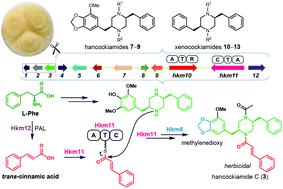当前位置:
X-MOL 学术
›
Org. Biomol. Chem.
›
论文详情
Our official English website, www.x-mol.net, welcomes your
feedback! (Note: you will need to create a separate account there.)
Hancockiamides: phenylpropanoid piperazines from Aspergillus hancockii are biosynthesised by a versatile dual single-module NRPS pathway
Organic & Biomolecular Chemistry ( IF 2.9 ) Pub Date : 2020-11-23 , DOI: 10.1039/d0ob02243h Hang Li 1 , Alastair E Lacey 2 , Si Shu 1 , John A Kalaitzis 3 , Daniel Vuong 2 , Andrew Crombie 2 , Jinyu Hu 1 , Cameron L M Gilchrist 1 , Ernest Lacey 4 , Andrew M Piggott 3 , Yit-Heng Chooi 1
Organic & Biomolecular Chemistry ( IF 2.9 ) Pub Date : 2020-11-23 , DOI: 10.1039/d0ob02243h Hang Li 1 , Alastair E Lacey 2 , Si Shu 1 , John A Kalaitzis 3 , Daniel Vuong 2 , Andrew Crombie 2 , Jinyu Hu 1 , Cameron L M Gilchrist 1 , Ernest Lacey 4 , Andrew M Piggott 3 , Yit-Heng Chooi 1
Affiliation

|
The hancockiamides are an unusual new family of N-cinnamoylated piperazines from the Australian soil fungus Aspergillus hancockii. Genomic analyses of A. hancockii identified a biosynthetic gene cluster (hkm) of 12 genes, including two single-module nonribosomal peptide synthetase (NRPS) genes. Heterologous expression of the hkm cluster in A. nidulans confirmed its role in the biosynthesis of the hancockiamides. We further demonstrated that a novel cytochrome P450, Hkm5, catalyses the methylenedioxy bridge formation, and that the PAL gene hkm12 is dispensable, but contributes to increased production of the cinnamoylated hancockiamides. In vitro enzymatic assays and substrate feeding studies demonstrated that NRPS Hkm11 activates and transfers trans-cinnamate to the piperazine scaffold and has flexibility to accept bioisosteric thienyl and furyl analogues. This is the first reported cinnamate-activating fungal NRPS. Expression of a truncated cluster lacking the acetyltransferase gene led to seven additional congeners, including an unexpected family of 2,5-dibenzylpiperazines. These pleiotropic effects highlight the plasticity of the pathway and the power of this approach for accessing novel natural product scaffolds.
中文翻译:

Hancockiamides:通过多功能双单模块NRPS途径生物合成了来自汉曲霉的苯丙哌啶
hancockiamides是来自澳大利亚土壤真菌hancockii的N-肉桂酸哌嗪的新家族。汉考球菌的基因组分析确定了12个基因的生物合成基因簇(hkm),包括两个单模块非核糖体肽合成酶(NRPS)基因。hkm簇在构巢曲霉中的异源表达证实了其在汉考酰胺的生物合成中的作用。我们进一步证明,新型细胞色素P450 Hkm5催化亚甲二氧基桥的形成,并且PAL基因hkm12是可有可无的,但有助于增加肉桂酸汉考克胺的产生。体外酶法测定和底物补料研究表明,NRPS Hkm11激活反式肉桂酸酯并将其转移至哌嗪支架上,并具有接受生物等排噻吩基和呋喃基类似物的灵活性。这是第一个报道的肉桂酸酯激活真菌NRPS。缺少乙酰转移酶基因的截短簇的表达导致了另外七个同类物,包括一个意想不到的2,5-二苄基哌嗪家族。这些多效效应突出了途径的可塑性,以及这种方法获得新型天然产物支架的能力。
更新日期:2020-11-27
中文翻译:

Hancockiamides:通过多功能双单模块NRPS途径生物合成了来自汉曲霉的苯丙哌啶
hancockiamides是来自澳大利亚土壤真菌hancockii的N-肉桂酸哌嗪的新家族。汉考球菌的基因组分析确定了12个基因的生物合成基因簇(hkm),包括两个单模块非核糖体肽合成酶(NRPS)基因。hkm簇在构巢曲霉中的异源表达证实了其在汉考酰胺的生物合成中的作用。我们进一步证明,新型细胞色素P450 Hkm5催化亚甲二氧基桥的形成,并且PAL基因hkm12是可有可无的,但有助于增加肉桂酸汉考克胺的产生。体外酶法测定和底物补料研究表明,NRPS Hkm11激活反式肉桂酸酯并将其转移至哌嗪支架上,并具有接受生物等排噻吩基和呋喃基类似物的灵活性。这是第一个报道的肉桂酸酯激活真菌NRPS。缺少乙酰转移酶基因的截短簇的表达导致了另外七个同类物,包括一个意想不到的2,5-二苄基哌嗪家族。这些多效效应突出了途径的可塑性,以及这种方法获得新型天然产物支架的能力。











































 京公网安备 11010802027423号
京公网安备 11010802027423号